Rigel is generally the seventh-brightest star in the night sky and the brightest in the Orion constellation.
Key Facts & Summary
- Rigel is a variable star, thus it is occasionally outshone by Betelgeuse.
- Contrasting with the orange-red Betelgeuse, Rigel appears as blue-white to the naked eye.
- Rigel is also a multiple star system – composed of at least four stars.
- Rigel is a massive blue supergiant with a luminosity of around 61.500 up to 363.000 that of the Sun.
- The blue star is estimated to be around 860 light-years away.
- Its radius is around 70 times that of the Sun, with surface temperatures of 12.100 K.
- Pulsations cause brightness variations, as such, Rigel is classified as an Alpha Cygni variable.
- Rigel, together with Betelgeuse, Bellatrix and Alnilam are the navigational stars of the Orion constellation.
- Rigel is commonly depicted as the foot of Orion.
- Rigel marks one of the vertices of the Winter Hexagon, a large asterism that dominates the evening sky during the northern hemisphere winter.
- This star can be seen from all locations across Earth, with the exception of those within 8 degrees of the North Pole. The best month for viewing Rigel is January.
- Blue supergiants like Rigel usually exhaust their fuel at a far quicker rate than smaller stars. Because of this, these types of stars tend to live only a few million years.
- Rigel has been estimated to be just 8 million years old and has already depleted its supply of hydrogen at its core.
- As time passes by, Rigel will expand to an even greater size transcending into a red supergiant.
- The star may eventually explode as a supernova. It is one of the closest supernova progenitors to Earth and when it will explode it will become the second-brightest object in the night sky.
- Rigel has around 21 solar masses.
The name Rigel is derived from Arabic, meaning leg or foot. It was named as such because of its location, representing Orion’s foot. It is also commonly known as Beta Orionis.
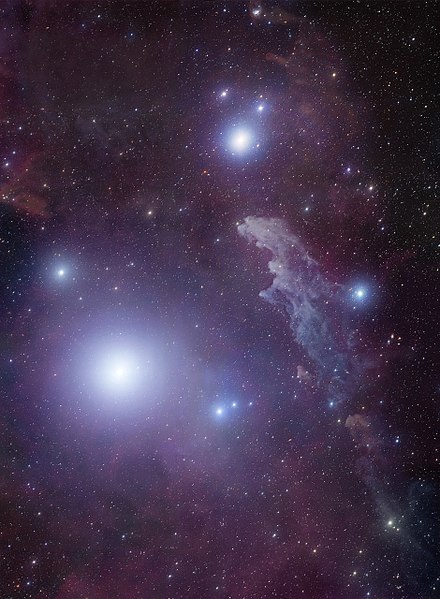
Rigel has an apparent magnitude ranging from 0.05 to 0.18. It is the first bright star of Orion when the constellation rises. Though it appears to the naked eye as a single star, Rigel actually has three other companions.
Formation
Supergiants such as Riegel, are evolved high-mass stars, larger and more luminous than main-sequence stars. Blue supergiants are newly evolved from the main sequence, have extremely high luminosities, high mass-loss rates, and are generally unstable.
Many of them become luminous blue variables, with episodes of extreme mass loss. Lower mass blue supergiants continue to expand until they become red supergiants. Rigel is believed to have formed around 8 million years ago.
Distance, Size, and Mass
Rigel is 860 light-years / 265 parsecs away from Earth and has a radius of about 75 times greater than the Sun. The diameter of Rigel has been estimated to be around 65 million miles / 105 million kilometers.
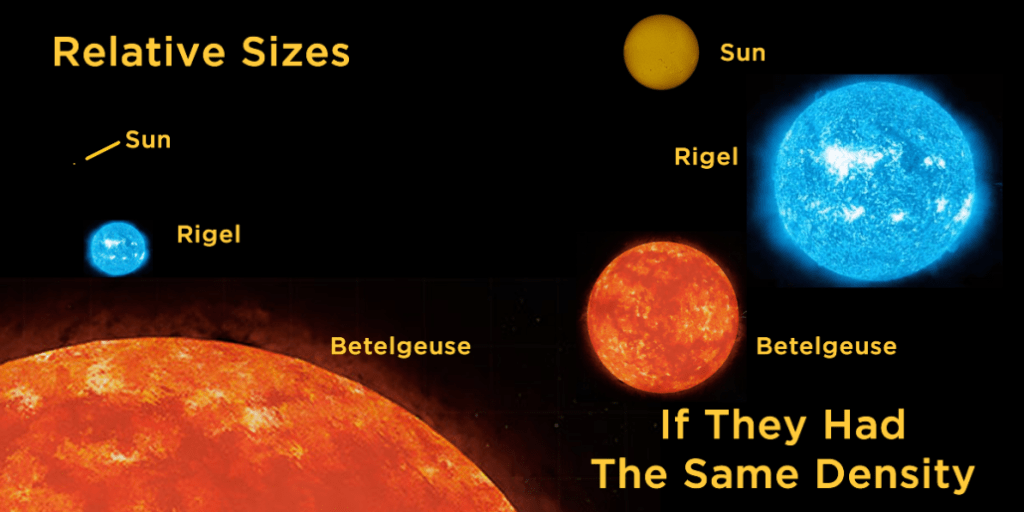
Rigel is estimated to have around 21 solar masses. However, Rigel is losing around 10 million times more mass than the rate of the Sun. The terminal wind velocity has been estimated to be around 300 km / 186 mi per second. It is believed that Rigel has already lost 3 solar masses since it was formed.
Star System
The Rigel star system has at least 4 components currently discovered. The blue supergiant has a visual companion, which is likely a close triple star system. A fainter star much farther from Rigel might also be a component.
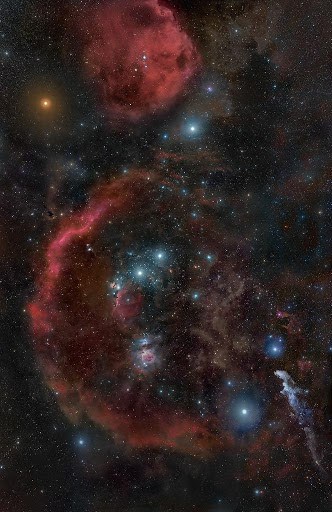
The secondary star is referred to as Rigel B. The angular rotation of Rigel B from Rigel A is 9.5 arc seconds to its south. It has a visual magnitude of 6.7, but it is still hard to spot.
At Rigel’s estimated distance, Rigel B’s projected separation from its primary is over 2.200 AU. Interestingly, since its discovery, there haven’t been any signs of orbital motion. Though, both stars appear to share the same proper motion. The pair would have a minimum orbital period of around 18.000 years.
The next companion is named Rigel C. They have a measured separation from component B that varies from less than 0.1 to around 0.3. Recent observations showed the two identical components separated by 0.124, with visual magnitudes of 7.5 and 7.6.
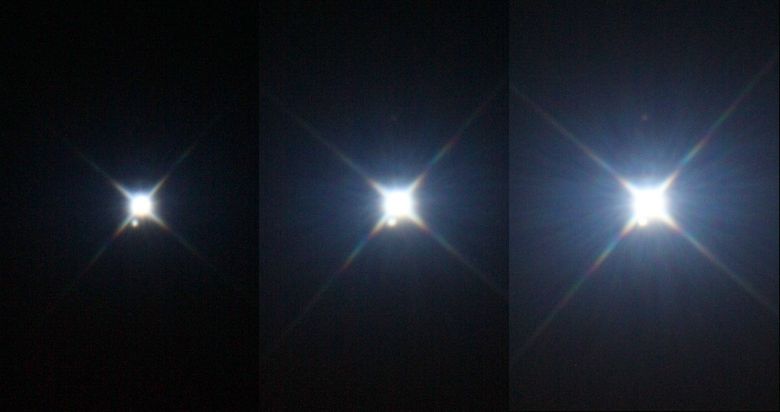
Their estimated orbital period is 63 years. The two spectroscopic components Rigel Ba and Rigel Bb cannot be resolved in optical telescopes but are known to be hot stars of spectral type around B9.
This spectroscopic binary, together with the close visual component Rigel C, is likely a physical triple star system, although Rigel C cannot be detected in the spectrum which is inconsistent with its observed brightness. Rigel C is estimated to have around 3.8 solar masses.
The fourth companion of Rigel, named Rigel D is still disputed to be part of the system. In 2017, its separation from Rigel was 44.5. Gaia DR2 finds it to be a 12th magnitude sun-like star at approximately the same distance as Rigel.
Likely an orange dwarf, this star would have an orbital period of around 250,000 years, if it is part of the Rigel system. Observations continue.
Location
Rigel’s location is:
- Right ascension: 5 hours 14 minutes 32.3 seconds
- Declination: -8 degrees 12 minutes 6 seconds
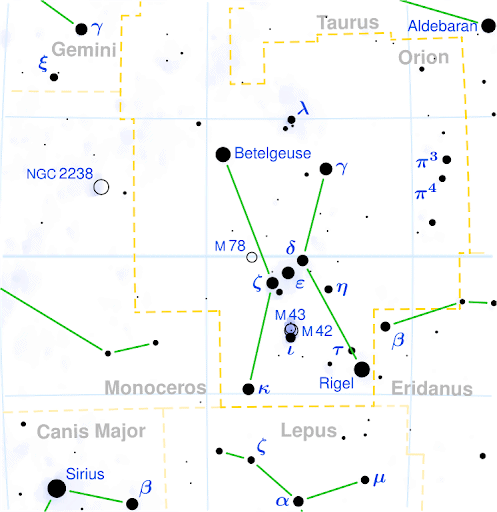
It is part of the Orion constellation where another famous star resides, Betelgeuse. Rigel resides in the left foot of Orion appearing as the bottom right star of Orion’s hourglass to northern observers and as the top left to observers in the southern hemisphere.
The Future
Rigel will explode as a supernova in the far future. This explosion will make Rigel the second-brightest object in the night sky for several weeks. What will happen to Rigel afterward is up for debate. It will either become a neutron star or a black hole.
Did you know?
- The name Rigel dates back to the 10th century while the earliest known written mention of it is in the Alfonsine Tables of 1521.
- For the Chinese, Rigel was known as the Seventh Star of Three Stars, referring to the Chinese three stars asterism.
- The Lacandon people of Mexico called Rigel, tunsel, which roughly translates to the little woodpecker.
- The Maori people of New Zeeland knew the star as Puanga. Puanga was the daughter of Rehua, the chief of all-stars, represented by Antares.
- The Japanese Genji clan chose Rigel as their symbol. A rival clan named Taira, chose Betelgeuse as their symbol. These clans faced each other in the Genpei War and Rigel and Betelgeuse were seen as facing off against each other in the sky.
- If Rigel would replace our Sun, all life on Earth would be exterminated since Rigel is at least 2 times hotter than our Sun.
Sources:
Image source:
- https://upload.wikimedia.org/wikipedia/commons/thumb/4/4a/Treasures3.jpg/440px-Treasures3.jpg
- https://wp-assets.futurism.com/2015/05/star-size-comparison.png
- https://upload.wikimedia.org/wikipedia/commons/thumb/4/47/Orion_Head_to_Toe.jpg/664px-Orion_Head_to_Toe.jpg
- http://sebastro.homeip.net/astro/galleries/Misc/html/Rigelx3.html[5.] https://upload.wikimedia.org/wikipedia/commons/thumb/b/bf/Orion_constellation_map.svg/500px-Orion_constellation_map.svg.png
